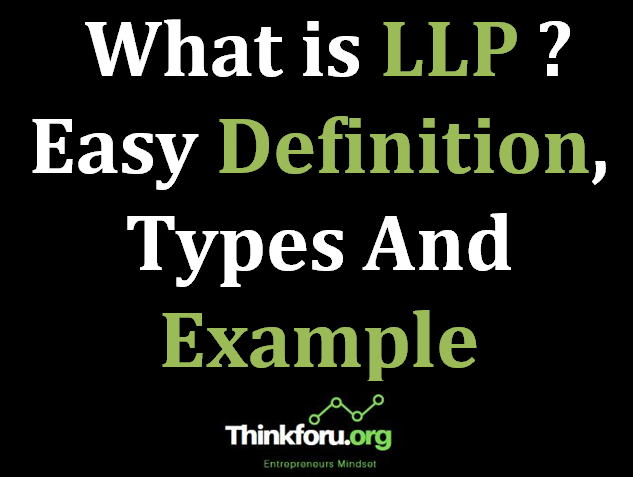What is LLP ? Easy Definition ,Types And Example
LLP stands for Limited Liability Partnership. It is a type of business structure that combines elements of both partnerships and corporations.
Here's a simple definition, types, and an example:
Definition of LLP :
A Limited Liability Partnership (LLP) is a legal structure where the partners have limited liability, meaning their personal assets are protected in case of business debts or liabilities. LLPs are a popular choice for professionals, such as lawyers, accountants, and consultants, who want the flexibility of a partnership but with limited personal liability.
Types of LLP:
1. General LLP: This is the most common type, where all partners have the authority to manage the business and have limited liability.2. Limited Liability Limited Partnership (LLLP): In some jurisdictions, an LLP can further limit the personal liability of the partners, making it an LLLP. This is not universally recognized in all regions.
Example:
Imagine two lawyers who decide to form a legal practice together as an LLP. They contribute capital, share profits and losses, and each has limited liability for the firm's debts. If the LLP faces financial issues or legal claims, the personal assets of the individual lawyers are protected, and they are not personally responsible for the full extent of the business liabilities.
Here's more information about Limited Liability Partnerships (LLPs):
Advantages of LLP:1. Limited Liability: As the name suggests, one of the main advantages is that the personal assets of the partners are protected from the business debts and liabilities.2. Flexibility in Management: LLPs often provide flexibility in the management structure, allowing partners to participate in the day-to-day operations without losing the protection of limited liability.3. Taxation: LLPs often have favorable tax treatment, with profits and losses passing through to the individual partners' tax returns.4. Perpetual Existence: An LLP can continue its existence even if one of the partners leaves or dies. The departure of a partner does not necessarily lead to the dissolution of the LLP.5. Ease of Compliance: LLPs generally have fewer compliance requirements compared to corporations, making them an attractive option for smaller businesses.
Disadvantages of LLP:1. Limited Capital Raising: LLPs may find it more challenging to raise capital compared to corporations because they cannot issue stock.2. Complex Formation: The process of forming an LLP can be more complex than a general partnership, involving more paperwork and formalities.3. State-Specific Regulations: LLP regulations can vary significantly between states or countries, and compliance with local laws is crucial.4. Limited in Some Professions: In certain jurisdictions, LLPs may be restricted for use by specific professional groups, such as lawyers, accountants, and architects.
Example Continued:Continuing with the example of the law firm as an LLP, the two lawyers may decide to bring in additional partners as the firm grows. Each partner enjoys the benefits of limited liability, and the profits or losses generated by the firm are distributed among the partners according to the terms outlined in the LLP agreement.
Let's delve deeper into some aspects of Limited Liability Partnerships (LLPs):
Formation of LLP:
1. Agreement: Forming an LLP typically involves drafting an LLP agreement. This document outlines the rights and responsibilities of each partner, profit-sharing arrangements, and other crucial aspects of the partnership. It is a key legal document that helps prevent disputes and provides a framework for decision-making.
2. Registration: LLPs usually need to be registered with the appropriate government authorities. The registration process involves submitting the necessary documents, such as the LLP agreement, to the designated regulatory body.
3. Name: LLPs must choose a unique name that complies with local regulations. The chosen name should not be identical or too similar to existing business names to avoid confusion.
Management and Decision-Making:
1. Management Flexibility: LLPs often provide flexibility in terms of management structure. Partners can actively participate in running the business or appoint designated managers to handle day-to-day operations.
2. Decision-Making: The LLP agreement typically outlines how decisions are made within the partnership. This can include voting mechanisms, decision-making thresholds, and procedures for resolving disputes among partners.
Taxation:
1. Pass-Through Taxation: LLPs often benefit from pass-through taxation, meaning that the profits and losses "pass through" to the individual partners, who report this income on their personal tax returns. This avoids the double taxation that corporations may face.
2. Tax Planning: Partners can engage in tax planning strategies to optimize their tax liabilities, taking advantage of deductions and credits available to them as individual taxpayers.
Conversion and Dissolution:
1. Conversion: LLPs may have the option to convert to other business structures, such as a limited company or corporation, if the business needs evolve over time.
2. Dissolution: If partners decide to end the LLP, the process of dissolution involves settling debts, distributing assets, and fulfilling any remaining legal obligations. The LLP agreement usually outlines the procedures for dissolution.
Liabilities and Protections:
1. Limited Liability: Partners in an LLP are shielded from personal liability for the debts and actions of the business. Their liability is generally limited to the amount they have invested in the partnership.
2. Exceptions: While partners typically have limited liability, there may be exceptions, such as cases of fraud or wrongful acts committed by a partner. It's essential to understand the specific legal nuances in the jurisdiction where the LLP operates.
It's important to note that the specific rules and regulations regarding LLPs can vary by jurisdiction, so it's advisable to consult local laws and seek professional advice when considering this business structure.
It's essential for partners to have a comprehensive LLP agreement in place, outlining the rights, responsibilities, and profit-sharing arrangements to avoid misunderstandings and conflicts. Additionally, regular communication and adherence to local regulations are crucial for the smooth operation of an LLP.
These additional details provide a more comprehensive understanding of how LLPs operate, their legal requirements, and the considerations involved in their formation and management.


Post a Comment